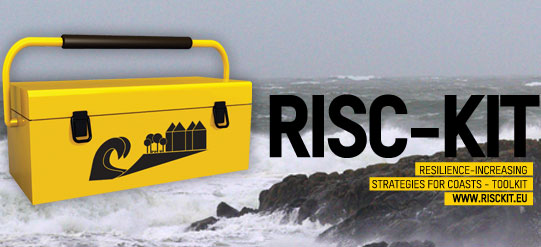Apart from taking into account climate change, relative sea level rise and rapid economic development as factors influencing coastal vulnerability, RISC-KIT also focuses on the social component of these issues. To this end, an Internal Synthesis Report was developed, aggregating interdisciplinary data from 11 Case Study sites.
The aim of the RISC-KIT project is to deliver an open-source and open-access toolkit, including methods, tools and management approaches to reduce risk and increase resilience to high-impact climatological events in the coastal zone. These products will enhance forecasting, prediction and early warning capabilities, improve the assessment of long-term coastal risk, evaluate coastal Disaster Risk Reduction (DRR) strategies and optimize the mix of prevention, mitigation and preparedness measures. Apart from taking into account climate change, relative sea level rise and rapid economic development in coastal zones, RISC-KIT will also focus on the social component of the issue by assessing the alternative ways that communities perceive and react to hazardous events. To this end, the RISC-KIT consortium has developed an Internal Synthesis Report that aggregates the full range of socio-economic, cultural and physical data from 10 European coastal case study sites and one site in Bangladesh.
The key importance of this Deliverable is the integration of the great variety of geomorphological settings, land uses, hazard types, socio-economic and environmental characteristics demonstrated in these areas, along with their cultural and institutional variability. Apart from being innovative, this task is the first step towards the development of a flexible toolkit for efficient and comprehensive coastal risk management, which will benefit coastal communities.
The Internal Synthesis Report combines information from more than 150 face-to-face interviews, conducted in the 11 Case Study sites, engaging stakeholders from a wide range of expertise, knowledge, motivation, and backgrounds and recounting the experiences of DRR and management measures in these areas. The interviews were supported by information obtained though broad review of existing quantitative, qualitative and spatial data. The initial findings of this investigation not only underline the influence of the physical, geomorphological characteristics but also of the socioeconomic, cultural and political diversities on the actions taken to reduce risk and prevent disasters. Through this internal deliverable and by analysing and understanding this diversity, RISC-KIT aims to implement the acquired knowledge in the best possible way, to enhance the success of hazard management and increase risk resilience in coastal zones, in close collaboration with the local end-users and stakeholders.




